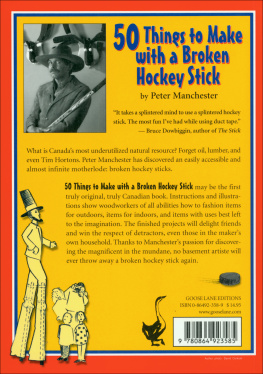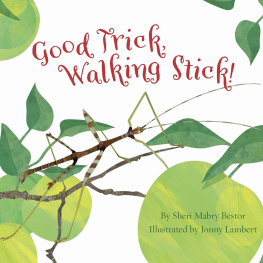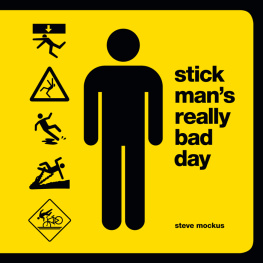50 Things to Make
with a Broken
Hockey Stick
50 Things to Make
with a Broken
Hockey Stick
PETER MANCHESTER
Text and illustrations copyright Peter Manchester, 2002.
All rights reserved. No part of this work may be reproduced or used in any form or by any means, electronic or mechanical, including photocopying, recording, or any retrieval system, without the prior written permission of the publisher. Any requests for photocopying of any part of this book should be directed in writing to the Canadian Copyright Licensing Agency.
Edited by Rhona Sawlor.
Cover illustrations by Peter Manchester.
Cover design by Paul Vienneau.
Book design by Julie Scriver.
Printed in Canada by Transcontinental Printing.
10 9 8 7 6 5 4 3 2 1
National Library of Canada Cataloguing in Publication
Manchester, Peter, 1952
50 things to make with a broken hockey stick / Peter Manchester, author and illustrator.
Includes index.
ISBN 0-86492-358-9
1. Hockey sticks Humor. 2. Hockey sticks. 3. Canadian wit and humor (English) I. Title. II. Title: Fifty things to make with a broken hockey stick.
PN6231.H54M35 2002 C818'.602 C2002-903640-2
Published with the financial support of the Canada Council for the Arts, the Government of Canada through the Book Publishing Industry Development Program, and the New Brunswick Culture and Sports Secretariat.
Goose Lane Editions
Suite 330, 500 Beaverbrook Court
Fredericton, New Brunswick
CANADA E3B 5X4
www.gooselane.com
Table of Contents
Introduction
Skating on the first ice of winter, hockey stick in hand, makes a person feel like an artist gazing on a newly gessoed canvas: anything is possible. The most outrageous manoeuvres seem attainable, the season brims with possibilities. Sadly, gravity, dexterity, and a host of other factors chip away at our fantasy, and reality comes calling. All aspiring athletes feel the inequality between ourselves and the pros. Yet every last player in the NHL uses the same tools and equipment available to the local rink rat. Of course, the professional players skates and stick might cost many hundreds of dollars, and the uniforms and padding are all customized and therefore very expensive. But every hockey player has a hockey stick that is much like everyone elses. Research shows that price is the number one factor in buying a hockey stick. Most of us are cheapskates (cheap-sticks?), but, no matter how much we pay, every stick can end up broken and discarded.
When a hockey players exuberance on ice leads to the busting up of a hockey stick, and it is cast aside, seemingly worthless, a small thought balloon pops up. In the recesses of any hockey-obsessed brain, a premonition lurks: a broken stick is not trash. It has potential, unseen possibilities. As the gardens of hockey playing families will attest, broken sticks make great tomato stakes in the rough sledding months of summer, but take heed: they are a resource worthy of greater works.
The hockey stick has a spotty and colourful past. Theories vary as to who came up with the first one. Like anyone flummoxed by research, I have made up my own Eurocentric version, based on no research whatsoever, with apologies to the true pioneers.
1. Ice Sail
When the icy gales of December blow, forget this hockey business. With broken hockey sticks and a garbage bag, you can fly across the ice like a paleo fun-seeker with his mammoth rib rig. If you have awning scraps, or, heaven forbid, you buy a length of sailcloth, your ice sail will last longer.
Make an A shape out of three pieces of broken stick, drill holes, and bolt them together. Keep the bolt ends facing away from you and cover them with duct tape. (A high speed encounter with metal parts can be unpleasant.) An extra cross piece near the point makes a useful handle and gives better balance under full sail. Use a staple gun to attach the awning fabric/sailcloth/garbage bag. If you are using a garbage bag, the copious use of duct tape is advisable along the stapled edges.
Ice is derived from the Sanskrit word for smooth, according to author Wayne Grady. That is the kind of ice you want, and you will wear your skates. Youll be surprised how fast youll go in a brisk wind. This experiment might have a Darwinian component, should you test the sail without first testing the ice. To avoid a frigid demise, stay off thin or bumpy ice, and remember that this sail will take you into uncharted territory quickly. Technique is up to you just remember your tacks, jibe, scuppers, and poop decks, and youll do fine.
2. Mock Moose
A more handsome trophy could be purchased for a few bucks at a yard sale, but this proud testimony to your sense of home decor can be yours FREE with just the slight bloodying of your knuckles. Your spouse may protest, but shed complain louder if you put up a real trophy head! Actually, unless you use a really old skate, you might achieve a trophy with no animal content whatsoever, barring carelessness with your own body parts.
Youll need a skate, the blade ends of four sticks, two ping-pong balls, a mounting board, and plenty of black stick tape. Carefully slice down the back seam of the skate, and pull each side outwards to form the mooses ears. Tape these up to give them a good ear shape. For the antlers, cut the sticks so that the shafts are the same length, no more than 8" long. Cut the ends of the first two sticks at a slight angle so they fit together in a V. Find a scrap piece of stick. Holding the two antlers at the desired angle, pre-drill holes through them and the piece of scrap to make the brace that will hold the antlers in place.
Using a sharp utility knife, and cutting away from yourself, cut a hole the same size as the stick, about 3/4" x 1 1/8", out of each side of the heel. They should be the same height above the sole and the same distance from the heel support because youll insert one stick into each to form the first tier of antlers. The cuts are tough to make, so take your time.
Insert the first two antlers through the holes in the skate and screw the rack together using the brace youve already made. Add the next tier of antlers by screwing these to the mounted ones. Attach them from the back with screws no longer than the combined thickness of the sticks. Theoretically, you could make a really big rack, but I stopped at a modest four-pointer.
Next page





















